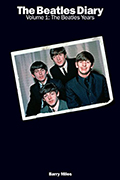Location
Location: Royal Albert Hall, London, UK
Timeline
Previous article May 19, 1966 • Paul McCartney and John Lennon listen to the Beach Boys' "Pet Sounds"
Film May 20, 1966 • Shooting of "Rain (Version 3 - Colour)" promo film
Session May 26, 1966 • Recording "Yellow Submarine"
Article May 27, 1966 • The Beatles attend Bob Dylan's concert in London
Article May 28, 1966 • The Beatles meet Bob Dylan
Single May 30, 1966 • "Paperback Writer / Rain (US)" by The Beatles released in the US
Related people
Related articles
Bob Dylan went on a tour across North America, Australia, and Europe from February to May 1966. Copenhagen was one of the stops, where he played on May 1st. After that, he headed to London and met Paul McCartney on May 2. He then travelled to Dublin for a concert on May 5 and continued to perform in England, Wales, and France. On May 26 and 27, Bob Dylan performed two shows in London, which were attended by the Beatles and their partners. After the concert, they all spent the night talking at the Mayfair Hotel.
On May 28, The Beatles visited Dylan again in his hotel room in London.
The Beatles were at his final date, along with Cynthia, Jane, Pattie, Maureen, Tony Bramwell, and friends, all of them occupying one of the venue’s prestigious private boxes. Dylan was at his glorious height as a Byronic rock poet—his skinny body wrapped in the latest mod clothes, his hair billowing out in a mass of curls, and an electric guitar in his hands. Yet, despite having reached this peak, his performance was still mired in controversy. The fans who had discovered him as a scrawny folkie singing starkly realistic songs in defense of the poor, oppressed, and forgotten people of America were perplexed by his adoption of what they thought of as rock ’n’ roll–style music and lyrics as obscure as those of T. S. Eliot or the nineteenth-century French symbolist poets. He was now loud and difficult. […]
After the concert the four Beatles and their partners along with Tony Bramwell accompanied Dylan to the Mayfair Hotel, where he talked with them all night in his suite. Bob Johnston, who had produced Blonde on Blonde, believed that it was a significant moment for the group. He would say, “When the Beatles left his room, they weren’t the Beatles anymore. They were John Lennon, George Harrison, Paul McCartney and Ringo Starr, in terms of how they thought about themselves. They were different people. It went on from there.”
To D. A. Pennebaker, though, it was an awkward encounter, not much of an advance on Paul’s earlier meeting. The Beatles, he felt, were easy to talk to individually, but together they relied on a style of banter built up over years of being in close proximity to each other that was superficial yet powerful enough to keep outsiders at a distance. “When all four of them were together they had this conversational attack mode that they used on anyone who was not part of that group,” Pennebaker told me. “It wasn’t very interesting conversation and Dylan watched it but was not drawn into it much.”
From “Beatles ’66: The Revolutionary Year” by Steve Turner










